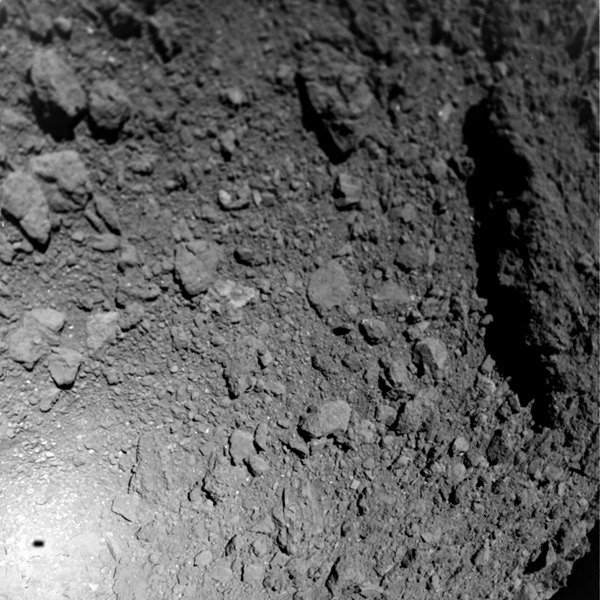The latest photos of Hayabusa2’s mission to asteroid Ryugu – Astronomy Magazine
This image shows that MASCOT moved turbulently towards Ryugu, as expected, performing turns and rollovers. The images show a huge boulder, which occupies the eastern (right) edge of the image and is several tens of meters in length. Note MASCOT’s shadow on Ryugu to the lower left.
Jaumann et al., Science 2019
The solar system is a crowded place. Earth may be the only planet with humans on it, but many worlds are home to robots — rovers and landers and orbiters, gathering data for astronomers. Asteroid (162173) Ryugu joined them last summer, and has been playing host to the Japanese spacecraft Hayabusa2. The mission has already collected lots of great data.
Now, according to a report Thursday in Science, we have some more information on the diamond-shaped Ryugu. Hayabusa2’s Mobile Asteroid Surface Scout (MASCOT) lander, which touched down last October, snapped several pics along the way. An international team of scientists analyzed them to gain new insights into the ancient world, helping them understand its violent past and even learning a little about the ancient solar system.
Now, according to a report snapped several pics along the way. An international team of scientists analyzed them to gain new insights into the ancient world, helping them understand its violent past and even learning a little about the ancient solar system.
 Bringing the universe to your door. We’re excited to announce Astronomy magazine’s new Space and Beyond subscription box – a quarterly adventure, curated with an astronomy-themed collection in every box. Learn More >>.
Bringing the universe to your door. We’re excited to announce Astronomy magazine’s new Space and Beyond subscription box – a quarterly adventure, curated with an astronomy-themed collection in every box. Learn More >>.
Rocky landing
MASCOT’s descent onto Ryugu was surprisingly low tech: Hayabusa2, already in orbit, simply “let go” of the lander and let it fall to the surface.The hardy device, packed with a camera (named MASCam) and other instruments,tumbled down slowly, freefalling about 134 feet for roughly 6 minutes before landing with a thud. It bounced another 56 feet before finally coming to a rest.
This was all on purpose. The German Aerospace Center designed MASCOT for the rough journey, and it snapped photos the whole way. The lander also carried a spinning weight which could re-orient and even move the tiny craft, allowing it to gather data from various locations. And thanks to the tried and true methods of flash photography, the machine could even snap pics in the dark. After more than 17 hours, and a few more hops, MASCOT’s batteries died out and this part of the mission was complete.







